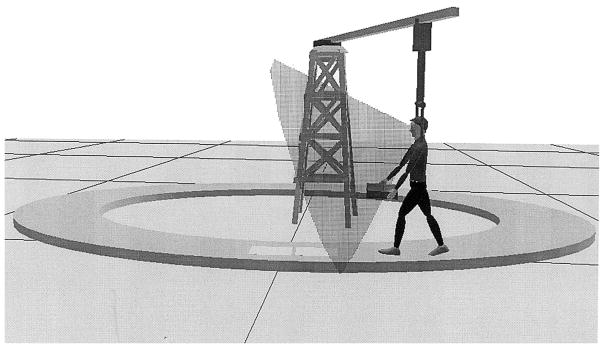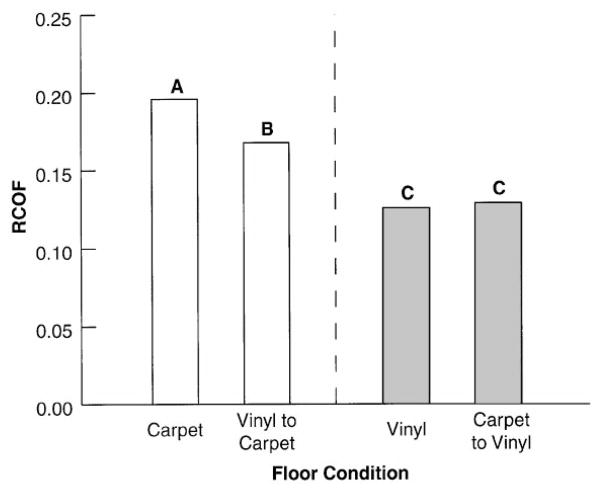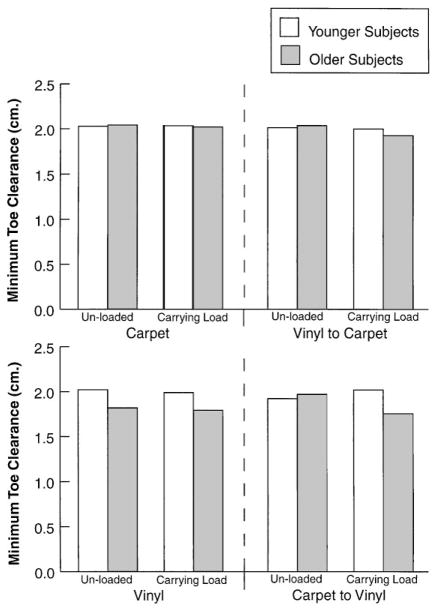Abstract
A laboratory study was conducted to examine gait changes between younger and older subjects as they walked across different floor surfaces. Twenty subjects participated in the experiment (five each of older and younger males and females). For half of the trials, subjects carried light loads that blocked their view of the floor surface immediately in front of them. Subjects walked on slippery (soapy water on vinyl) and stable (outdoor carpet) floor surfaces, as well as transitioning from one surface to another. Responses studied included: required coefficient of friction (RCOF), stride length (SL), and minimum toe clearance (MTC). Significant effects were found for the floor surface, load versus no load condition, and some interactions involving age (older versus younger subjects). Not all expected differences due to age were found in this experiment. The lack of significant differences between younger and older subjects could be due to the older subjects that participated in the experiment. They were volunteers at a local medical center, were in good physical shape, and were probably not typical of the population of people over 65 years of age.
Relevance to industry
Slips and falls in industry are costly safety issues in terms of human suffering as well as financial compensation. In many facilities and at home, people make transitions from one floor surface to another many times each day, while carrying loads or just walking. A better understanding of characteristics of people as they walk on slippery floor surfaces and the changes that might occur with age, will allow engineers to design better floor surfaces to reduce the incidence of slips and falls.
Keywords: Slips, Gait characteristics, Transitional floor surfaces, Gait changes with age
1. Introduction
Among older people, falls are the leading cause of death resulting from injury. The National Safety Council reported that in 1994, 13,300 Americans met their death by falling, of these deaths, 9923 were people over 65 years of age (National Safety Council, 1995). Falls and hip fractures among older persons rank as one of the most serious public health problems in the United States, with costs expected to escalate to over $16 billion by the year 2040 (Sattin, 1992; Cummings et al., 1990).
A review of the biomechanical literature indicates that there are several differences in the gait of older and younger people. Elderly people tend have a shorter step length and broader walking base, which results in an increase in stance time and double support time (Murray et al., 1969; Gillis et al., 1986; Imms and Edholm, 1979; Winter et al., 1990). These adaptations are thought to result in a more stable or safer gait pattern, but may have some important implications for slip-induced falls. Lockhart (1997) found that elderly individuals could not adjust their gait to reduce the required coefficient of friction (RCOF) as well as younger subjects on very slippery floor surfaces (oily vinyl tile). The RCOF is the measured ratio of the horizontal foot force to the vertical foot force and represents the minimum coefficient of friction that must be available at the shoe–floor interface to prevent slipping. The RCOF has been related to the tangent of the angle between the leg and a line perpendicular to the floor (Sherman, 1986). As a result, increasing the step length will, in general, increase RCOF (Perkins, 1978). Many researchers have observed that on slippery floor surfaces, subjects tended to shorten their stride length in order to reduce foot velocities and foot shear forces and reduce the likelihood of slipping (Cooper and Glassow, 1963; Ekkubus and Killey, 1973; Swensen et al., 1992). Lockhart (1997) found that younger subjects had longer stride lengths than older subjects and that floor slipperiness level affected stride length of both younger and older subjects.
Most current efforts to reduce the incidence of slip and fall accidents in elderly people have focused on physiological disabilities of the elderly. Changes in human sensory and motor abilities with age have been well documented (Tinetti and Speechley, 1989; Goldman, 1986; Cohn and Lasley, 1985; Tobis et al., 1985; Stelmach and Worringham, 1985). In addition, many studies have documented the decline of postural control (increased sway) due to sensory degradation among elderly individuals (Sheldon, 1963; Woolacott et al., 1982). This decline of postural control is believed to be an integrative process associated with a greater risk of falling (Isaacs, 1985; Brocklehurst et al., 1982; Overstall et al., 1977).
Compensatory postural control and the alerting process to an imminent fall may be initiated and maintained by proprioception, vision, and the vestibular system (Lacour et al., 1983; Nashner, 1982). However, any age-related deterioration in visual, proprioceptive, and vestibular signals concerning balance may produce a central signal detection problem, and to detect a peripheral stimulus correctly, a longer sampling period might be necessary (Clarkson, 1978; Gottsdanker, 1980; Kroll and Clarkson, 1978; Loveless, 1980). In addition, inputs from these systems may not be conformable for the elderly. For example, visual information (such as walking on two different floor surfaces [slippery and non-slippery] with same color and contrast) may be in conflict with proprioceptive and vestibular information. Many studies have shown that sensory conflict conditions have a greater effect on the sway pattern for elderly subjects as compared to their younger counterparts (Woolacott, 1986; Teasdale et al., 1991; Redfern et al., 1997). Thus in a situation where sensory conflicts exist due to the environment (e.g. transitional floor surfaces), sensory degradation among elderly individuals may increase the likelihood of slip and fall accidents.
Recently, Redfern et al. (1997) reported that the postural stability of elderly individuals was more affected by moving visual environments than for younger individuals. They also concluded that postural instability was most likely due to a function of the sensitivity of older people to visual and proprioceptive inputs and of their difficulty in handling sensory conflicts to the postural control system.
Thus, a combination of gait instability and sensory conflicts to the postural control system could influence the likelihood of slip and fall accidents. The sensitivity of older people to visual and pro-prioceptive inputs and of their difficulty in handling sensory conflicts during dynamic visual environments may further increase the likelihood of slip and fall accidents by the elderly.
In addition to falls initiated by a slip, tripping has been associated with a large number of falling injuries. Overstall et al. (1977), in a study of 240 subjects 60 years and over, revealed that the most common cause of falls was due to tripping (47%). This compares with Sheldon’s (Sheldon, 1960) total for trips (45%) resulting in accidental falls. The toe is last to leave the ground during normal level walking, and because of the angular relationship between the leg and foot the toe rises to no more than 2.5 cm above the ground and then drops to only 0.87 cm clearance at mid swing (Winter, 1991). This toe clearance occurs at the most dangerous phase of the toe trajectory (when the horizontal velocity is at its maximum). Furthermore, the location of the center of gravity at this time is at or ahead of the toe of the contralateral support foot (Ruder, 1989; MacKinnon, 1990; Shimba, 1984). Thus, with the forward momentum of the body at that instant it is impossible to recover with the contralateral limb, and consequently, the only recovery that is possible is with the swing limb. Winter et al. (1990), in a study of walking pattern changes in the fit and healthy elderly, revealed that elderly subjects had shorter toe clearance (1.12 cm) than younger subjects (1.29 cm).
The purpose of the study described in this paper was to investigate the biomechanical parameters of gait (such as the stride length, RCOF, and minimum toe clearance) during transition from a slippery to a non-slippery floor surface and vice versa. The effects of an obstruction of the immediate visual field due to carrying a load were also investigated. It was hypothesized that the load condition (obstruction of immediate visual field of the floor) and the transitional effects of floor surfaces would affect the gait pattern of older subjects more than their younger counterparts.
2. Method
2.1. Subjects
Ten college students (5 males and 5 females), and 10 elderly individuals (5 males and 5 females) participated in this experiment. The college students were recruited from the general student population at Texas Tech University and averaged 26 years of age (SD 4.4 years), 166 cm in height (SD 4.1 cm), and 55 Kg in weight (SD 5.3 kg). The elderly subjects (restricted to 65 years and older) were recruited from a pool of volunteers at the Texas Tech University Health Sciences Center and averaged 72 years of age (SD 4.35 years), 170 cm in height (SD 7.1 cm), and 77 kg in weight (SD 15.1 kg).
2.2. Apparatus
Two commonly used floor materials were used in this experiment: outdoor carpet (Beau Lieu 1/4″ Olefin) and vinyl tile (Armstrong). The vinyl tile surface was covered with a water and soap film to reduce the COF. The available dynamic COF (ADCOF) for each surface was measured using a standard 4.54 Kg (10 lb.) horizontal pull slipmeter with a rubber sole material and found to be 1.80 for the outdoor carpet and 0.13 for the soapy vinyl tile. For half of the trials subjects were asked to carry an empty foam box (0.6 Kg mass and 51 × 46 × 15 cm in dimensions). Walking trials were conducted using four different floor conditions corresponding to two uniform floor surface conditions and two transitional floor surface conditions. The uniform conditions had both the first and second portions of the track (see Fig. 1) covered with either the soapy vinyl tile or the outdoor carpet. Transitional conditions had either the first part of the track covered with the outdoor carpet and the second portion of the track covered with the soapy vinyl tile or vice versa.
Fig. 1.
Laboratory layout for the experiment, including: fall arresting rig, safety harness, force plates, floor materials, load, field of vision.
Walking trials were conducted on a circular track using an overhead fall arresting rig as shown in Fig. 1. The circular wooden track was approximately 0.9 m wide and 20 m in circumference. The test surface covered approximately one-half of the circumference of the track. A fall arresting rig was used to protect subjects from falling during the experiment. The rig consists of a full-body parachute harness attached to an automated overhead suspension arm. The rig was designed to permit the subject to fall approximately 15 cm before arresting the fall and stopping the forward motion. An Exper Vision Motion Analysis System was used to collect the three-dimensional posture data of the subjects as they walked over the test surface. Retro-reflectors were attached to the anatomically significant body positions: toe, heel, ankle, knee, and hip of the subject’s left side. Posture data were sampled and recorded at a rate of 180 Hz. The ground reaction forces of the subjects walking over the test surfaces were measured using two Bertec force plates also sampled at a rate of 180 Hz.
2.3. Procedures
The subjects attended a familiarization session before the experiment. During this session, the fall arresting system and the walking conditions were introduced to the subjects. During the experiment, the subjects walked across each floor condition for 5 min with and without the load (10 min total per day). Within the 5 min trial, 2 robust measurements of subject’s posture and ground reaction forces were recorded. Walking velocity for the experiment was based on cadence of 100 steps/min (average cadence based on Meserlian (1995)). A metronome provided an audible cue of 100 beats/min. Subjects walked on a different floor surface on each of four different days separated by at least one day. Because of the difficulties associated with changing floor surface conditions, all subjects completed each floor treatment condition in the same order, with the outdoor carpet surface (uniform condition) on the first day, soapy vinyl tile surface on the second day (uniform condition), transition from outdoor carpet to soapy vinyl tile surface on the third day (transitional condition), and transition from soapy vinyl tile to outdoor carpet on the final day (transitional condition). Standard shoes with rubber soles were supplied to all subjects to maintain constant COF levels.
2.4. Treatment of the data
The converted coordinate data for each of the body markers and the ground reaction forces were digitally smoothed using a fourth-order, zero-lag, low-pass Butterworth filter (Winter, 1990). Residual analyses of the difference between the filtered and the unfiltered signals over three different ranges of cutoff frequencies (6, 10, and 12 Hz) determined 6 Hz as the preferred cutoff frequency.
The dependent measures, required coefficient of friction (RCOF), stride length (SL) and minimum toe clearance (MTC), were analyzed first according to a 2 × 4 × 2 (age × floor × load) three-way MANOVA fixed model design on all dependent variables (RCOF, SL, and MTC). Afterwards, a 2 × 4 × 2 (age × floor × load) three-way repeated measures analyses of variance (ANOVA) was performed on each dependent variable with α = 0.5. For this analysis floor and load were treated as within-subjects effects, while age was a between-subjects effect. The p-values in the ANOVA were adjusted for violations of the assumptions regarding the variance–covariance matrix using the Huynh–Feldt method to estimate ε and adjusting the degree-of-freedom accordingly (Winer et al., 1991). In addition, constant variance and normality assumptions were verified using residual analysis and normality plots. A computer algorithm was written in the Mathematica to objectively determine SL, and MTC.
3. Results
3.1. Overall effect
A three-way multivariate analysis of variance (MANOVA) using the likelihood ratio test (Wilk’s Lambda) was used to test the hypothesis of no overall age, floor and load effect on the dependent measures RCOF, SL and MTC. The results of the three-way MANOVA indicated statistically (p < 0.05) significant overall floor and load effects on the dependent variables RCOF, SL and MTC (Table 1). Table 2 lists the mean value and standard deviation for each of the independent variables as a function of age.
Table 1.
Summary of the three-way MANOVA (fixed effect model with F approximations derived from Wilks’ lambda) on RCOF, SL and MTC of two age groups, four floor levels, and two load levels
| Factor | Wilks’ lambda | F | P-value |
|---|---|---|---|
| Age | 0.994 | 0.677 | 0.566 |
| Floor | 0.862 | 6.004 | > 0.001a |
| Load | 0.930 | 8.847 | > 0.001a |
Statistically significant at (α = 0.05).
Table 2.
The mean values and standard deviations (shown in parentheses) for each of the dependent measures as a function of age
| Variables | Young subjects | Elderly subjects |
|---|---|---|
| RCOF | 0.156 (SD 0.04) | 0.153 (SD 0.05) |
| Stride length (cm) | 127.60 (SD 10.06) | 121.05 (SD 16.46) |
| MTC (cm) | 2.00 (SD 0.22) | 1.92 (SD 0.37) |
3.2. Required coefficient of friction
The required coefficient of friction (RCOF) was obtained by dividing the horizontal ground reaction force by the vertical ground reaction force at heel contact (peak 3 as defined by Perkins and Wilson, 1983). The ANOVA analysis of RCOF showed significant effects for floor condition (F(3,54) = 24.95, p < 0.001, Huynh–Fedt ε = 0.954), and for the Age × Load interaction condition (F(1,18) = 9.43, p ≈ 0.007, Huynh–Fedt ε = 1.059). All other main effects and interactions were not significant (α > 0.05). The effects of floor condition on RCOF are shown in Fig. 2, with individual mean values compared using planned orthogonal comparisons (α = 0.05). Higher RCOF values indicate that subjects were exerting larger horizontal foot forces during walking. The figure indicates that subjects had higher RCOF values when walking on carpet than when transitioning from soapy vinyl tile to carpet and lower RCOF values when walking on soapy vinyl tile than when transitioning from carpet to soapy vinyl tile.
Fig. 2.
Main effect of floor condition on the required coefficient of friction (RCOF). Letters indicate groupings determined by paired orthogonal contrasts in the analysis of variance (α = 0.05). Means with same letters are not significantly different.
The Age × Load interaction for RCOF is shown in Fig. 3. The figure demonstrates that younger subjects had lower RCOF values when carrying the load than when walking unloaded. Curiously, the opposite effect can be seen for older subjects.
Fig. 3.
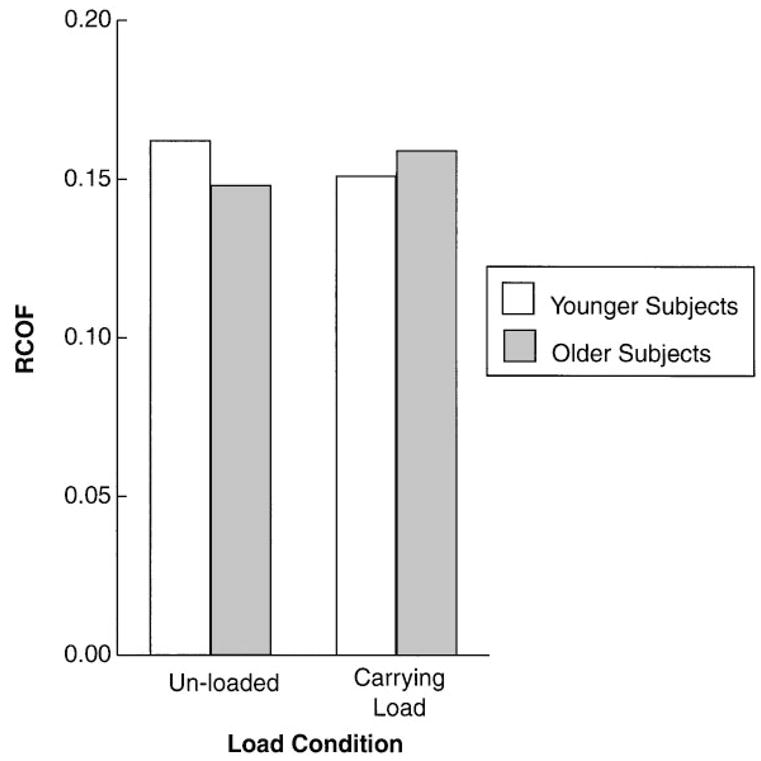
Load × Age interaction effect for required coefficient of friction (RCOF).
3.3. Stride length
The stride length (SL) was defined as the difference between consecutive positions of the heel contacting the floor. The ANOVA analysis of SL showed significant effects for floor condition (F(3,54) = 19.79, p < 0.001, Huynh–Fedt ε = 1.043), load (F(1,18) = 15.03, p ≈ 0.001, Huynh–Fedt ε = 1.059) and for the Age × Load condition interaction (F(1,18) = 4.57, p ≈ 0.047, Huynh–Fedt ε = 1.080). All other main effects and interactions were not significant (α > 0.05). The effects of floor condition on SL are shown in Fig. 4, with individual mean values compared using planned orthogonal comparisons (α =0.05). Stride lengths were longer for steps taken on the carpet surface as compared to the vinyl tile, and were shorter for steps transitioning from the carpeted surface to the vinyl tile than for the steps on the vinyl tile only.
Fig. 4.
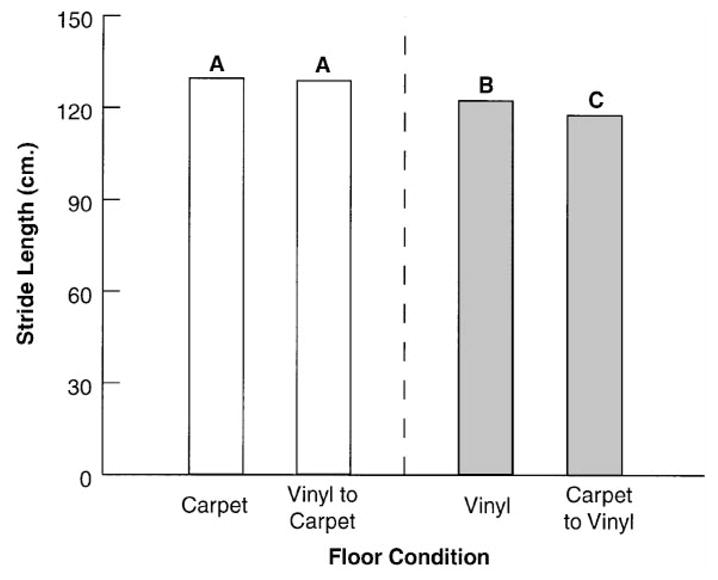
Main effect of floor condition on the stride length (SL). Letters indicate groupings determined by paired orthogonal contrasts in the analysis of variance (α = 0.05). Means with same letters are not significantly different.
The Age × Load interaction for SL is shown in Fig. 5. Younger subjects had longer stride lengths than older subjects. In addition, older subjects reduced their stride length on average 4.44 cm when carrying the simulated load, while younger subjects only reduced their stride length 1.28 cm when carrying the load.
Fig. 5.
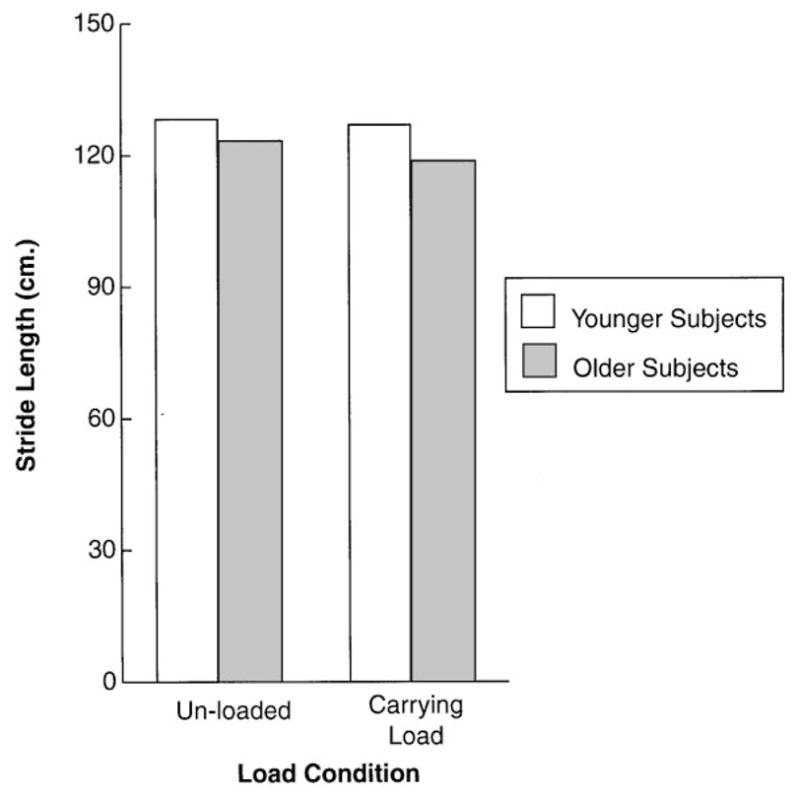
Load × Age interaction effect for stride length (SL).
3.4. Minimum toe clearance
The minimum toe clearance (MTC) was calculated using the minimum vertical height of a marker positioned near the toe during the mid stride of the gait cycle. The values were measured to evaluate the potential for a tripping accident. The ANOVA analysis of MTC showed significant effects for the Age × Load interaction (F(1,18) = 4.48, p ≈ 0.048, Huynh–Fedt ε = 1.059), and the Age × Load × Floor interaction (F(3,54) = 2.90, p ≈ 0.044, Huynh–Fedt ε = 0.995). All other main effects and interactions were not significant (α > 0.05). The Age × Load interaction is shown in Fig. 6. Older subjects had much smaller toe clearances when carrying the simulated load, while younger subjects showed very little effect due to the load.
Fig. 6.
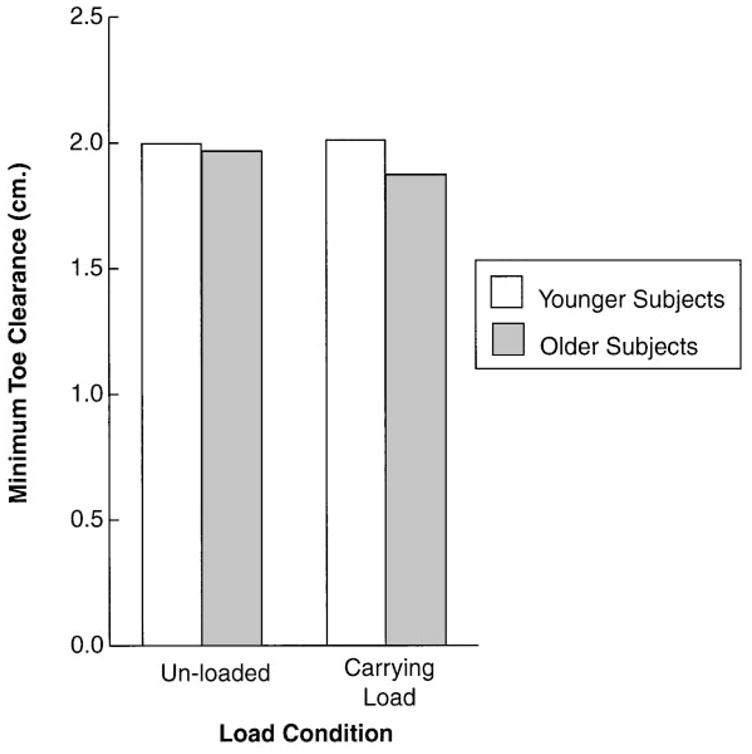
Load × Age interaction effect for minimum toe clearance (MTC).
The three-way interaction of Age × Load × Floor is shown in Fig. 7. Of note in this figure is that older subjects had a larger toe clearance when transitioning from carpet to vinyl when they were not carrying the load as compared to when they were carrying the load or other conditions on the vinyl surface.
Fig. 7.
Floor × Load × Age interaction effect for minimum toe clearance (MTC).
4. Discussion
This research project was undertaken to provide a better understanding of how transitional effects of floor surfaces and obstruction of the immediate visual field of the floor surface area affect biomechanical parameters of walking and ground reaction forces. As noted in the results, some of the expected age related factors did not prove to be statistically significant. Perhaps this was due to the nature of the older subject population or the relatively small sample size used in the study. The older subjects were recruited from volunteers at a local medical center. They were in good physical shape, exercised regularly, and had participated in similar experiments in the past. In short, the older subjects who participated in this experiment were most likely not representative of their age population. However, the fact that several interactions involving age were found significant for this study indicates that consideration of the working environment is important when designing facilities that will be used for older people, even those in good physical condition.
In contrast to the recent findings of Winter et al. (1990) no significant difference in SL was observed between older and younger subjects. Perhaps this lack of significant difference in SL between the younger and older subjects was due to the height differences between the two groups (mean height for younger subjects was 166 cm compared to 170 cm for older subjects) or the relatively small sample size used in the study. SL was longer for the no load condition than for the load condition, and younger subjects SL changed less than that of older subjects (during the load condition). These data suggest that subject’s SL was altered in order to compensate for the loss of the immediate visual field and/or awkward laden gait (arms holding an object). However, it seems that the load condition affected the gait pattern (SL) of older subjects more than their younger counterparts.
Overall, there was no significant difference between young and older individuals in terms of the RCOF during walking. Both groups had lower RCOF values when walking over the soapy vinyl surface than when walking over the carpeted surface, indicating that the gait pattern was adjusted to compensate for the slippery surface. Transition from the vinyl surface to the carpeted surface resulted in lower RCOF values that for walking across the carpeted surface alone.
Previous research comparing RCOF and SL (Perkins, 1978) revealed that RCOF increased with stride length during level walking. For the present study, the relationship between the stride length and RCOF was relatively low but significant (r = 0.27, p < 0.001). The correlation between the stride length and RCOF (r = 0.23, p < 0.001) for older individuals was lower than for their younger counterparts (r = 0.38, p < 0.001) (elderly individuals had shorter stride length and higher RCOF). The relatively low correlations between RCOF and SL indicate that strategies other than shortening the stride length may be used to reduce the RCOF at heel strike.
The minimum toe clearance (MTC) measure indicated no difference between older and younger subjects. Significant interactions for MTC were found for Load × Age and Floor × Load × Age. The older subject’s MTC decreased when carrying the load much more than the younger subjects who maintained MTC. The older subjects also tended to decrease their MTC as they transitioned for the carpet to the soapy vinyl tile. Overall, changes observed in MTC were very small and probably have limited practical significance.
One implication of the results of the present study is that the type of floors (especially the transitional floor surfaces) and carrying a light load may increase the potential for slip-induced falls. The environment has been implicated in one third to one half of all falls or fall-related injuries (Lucht, 1971; Haddon and Baker, 1981). In daily activities, transitions are made between very different floor surfaces, for example, walking from a carpeted area to a tiled bathroom area or a linoleum kitchen area. In addition, carrying a light load such as pillows, blankets or similar objects, is a common daily routine for elderly individuals. This implies that the types of floors placed in the homes of elderly individuals and in public places should minimize transitional floor surfaces and the elderly individuals should be made aware of the danger of slipping even when carrying a light load.
Although the results of present study are not dramatic, they indicated that walking on transitional floor surfaces and carrying a light load changed the biomechanical parameters of gait for elderly individuals more than their younger counterparts. Further study is needed to determine if gait characteristics of less active older people are significantly altered by transitional floor surfaces and/or carrying objects that block the visual field at the feet.
Acknowledgments
This research was supported in part by the Ministry of University Affairs of Thailand and the Institute for Ergonomics Research of the Department of Industrial Engineering at Texas Tech University.
References
- Brocklehurst JC, Robertson D, James-Groom P. Clinical correlates of sway in old age – sensory modalities. Age and Aging. 1982;11:1–10. doi: 10.1093/ageing/11.1.1. [DOI] [PubMed] [Google Scholar]
- Clarkson PM. The effect of age and activity level on simple and choice fractionated response time. European Journal of Applied Physiology. 1978;40:17–25. doi: 10.1007/BF00420985. [DOI] [PubMed] [Google Scholar]
- Cohn TE, Lasley DJ. Visual depth illusion and falls in the elderly. Clinical Geriatrics Medicine. 1985;1:601–610. [PubMed] [Google Scholar]
- Cooper JM, Glassow RB. Kinesiology. Mosby Company; New York: 1963. pp. 140–175. [Google Scholar]
- Cummings SR, Rubin SM, Black D. The future of hip fractures in the United States. Clinical Orthopaedics and Related Research. 1990;252:163–166. [PubMed] [Google Scholar]
- Ekkubus CF, Killey W. Validity of 0.5 static COF (James Machine) as a measure of safe walkway surfaces. Soap/Cosmetics/Chemical. 1973;49 (2):40–45. [Google Scholar]
- Gillis B, Gilroy K, Lawley H, Mott L, Wall JC. Slow walking speeds in healthy young and elderly females. Physiotherapy Canada. 1986;38:350–352. [Google Scholar]
- Goldman R. Decline in organ function with aging. In: Rossman I, editor. Clinical Geriatrics. Lippincott; Philadelphia: 1986. pp. 23–59. [Google Scholar]
- Gottsdanker R. Aging and the maintenance of preparation. Experimental Aging Research. 1980;6:13–27. doi: 10.1080/03610738008258343. [DOI] [PubMed] [Google Scholar]
- Haddon W, Baker SP. Injury control. In: Clark DW, MacMahion B, editors. Preventive and Community Medicine. 2. Little Brown and CO; Boston, MA: 1981. pp. 109–140. [Google Scholar]
- Imms FJ, Edholm OG. The assessment of gait and mobility in the elderly. Age and Aging. 1979;8:261–267. doi: 10.1093/ageing/8.4.261. [DOI] [PubMed] [Google Scholar]
- Isaacs B. clinical and laboratory studies of falls in old people. Clinical Geriatrics Medicine. 1985;1:513. [PubMed] [Google Scholar]
- Kroll W, Clarkson PM. Age, isometric knee extension strength, and fractionated resisted response time. Experimental Aging Research. 1978;4:389–409. doi: 10.1080/03610737808257163. [DOI] [PubMed] [Google Scholar]
- Lacour M, Vidal PP, Xerri C. Dynamic characteristics of vestibular and visual control of rapid postural adjustments. In: Desmedt J, editor. Motor Control Mechanisms in Health and Disease. Raven Press; New York: 1983. [PubMed] [Google Scholar]
- Lockhart TE. The ability of elderly people to traverse slippery walking surfaces. Proceedings of the Human Factors and Ergonomics Society 41st Annual Meeting; 1997. pp. 125–129. [Google Scholar]
- Loveless NE. Aging effects in simple RT and voluntary movement paradigms. Progress in Brain Research. 1980;54:547–551. doi: 10.1016/S0079-6123(08)61675-1. [DOI] [PubMed] [Google Scholar]
- Lucht U. a prospective study of accidental falls and resulting injuries in the home among elderly people. Acta Socio-Medica Scandinavica. 1971;3:105–120. [PubMed] [Google Scholar]
- MacKinnon CD. MSc Thesis. Unv. Waterloo; 1990. Control of whole body balance and posture in the frontal plane during human walking. [DOI] [PubMed] [Google Scholar]
- Meserlian E. The effects of walking cadence on static COF required by the elderly. Professional Safety. 1995;40:100–110. [Google Scholar]
- Murray MP, Kory RC, Clarkson BH. Walking patterns in healthy old men. Journal of Gerontology. 1969;24:169–178. doi: 10.1093/geronj/24.2.169. [DOI] [PubMed] [Google Scholar]
- Nashner LM. Analysis of movement control in man using the movable platform. In: Desmedt J, editor. Motor Control Mechanisms in Health and Disease. Raven Press; New York: 1982. [Google Scholar]; National Safety Council. Accidents Facts 1995 edition. Author; Itasca, IL: 1995. [Google Scholar]
- National Safety Council. Accidents Facts 1995 edition. Author; Itasca, IL: 1995. [Google Scholar]
- Overstall PW, Exton-Smith AN, Imms FJ, Johnson AL. Falls in the elderly related to postural imbalance. British Medical Journal. 1977;1:261–264. doi: 10.1136/bmj.1.6056.261. [DOI] [PMC free article] [PubMed] [Google Scholar]
- Perkins PJ. Measurement of slip between the shoe and ground during walking. American Society of Testing and Materials. Special Technical Publication. 1978;649:71–87. [Google Scholar]
- Perkins PJ, Wilson MP. Slip resistance testing of shoes – New developments. Ergonomics. 1983;26 (1):73–82. [Google Scholar]
- Redfern MS, Moore PL, Yarsky CM. The influence of flooring on standing balance among older persons. Human Factors. 1997;39 (3):445–455. doi: 10.1518/001872097778827043. [DOI] [PubMed] [Google Scholar]
- Ruder GK. MSc Thesis. Univ. Waterloo; 1989. Whole body balance during normal and perturbed walking in the sagittal plane. [Google Scholar]
- Sattin RW. Falls among older persons: A public health perspective. Annual Review of Public Health. 1992;13:489–508. doi: 10.1146/annurev.pu.13.050192.002421. [DOI] [PubMed] [Google Scholar]
- Sheldon JH. On the natural history of falls in old age. British Medical Journal. 1960;4:1685–1690. doi: 10.1136/bmj.2.5214.1685. [DOI] [PMC free article] [PubMed] [Google Scholar]
- Sheldon JH. The effect of age on the control of sway. Gerontologia Clinica. 1963;5:129. doi: 10.1159/000244784. [DOI] [PubMed] [Google Scholar]
- Sherman RM. Slip and fall accident prevention simplified. Professional Safety. 1986;2:40–43. [Google Scholar]
- Shimba T. An estimation of the center of gravity from force platform data. Journal of Biomechanics. 1984;17:53–60. doi: 10.1016/0021-9290(84)90080-0. [DOI] [PubMed] [Google Scholar]
- Stelmach GE, Worringham GJ. Sensorimotor deficits related to postural stability: Implecation for falling in elderly. Clinical Geriatrics Medicine. 1985;1:1679. [PubMed] [Google Scholar]
- Swensen E, Purswell J, Schlegel R, Stanevich R. Coefficient of friction and subjective assessment of slippery work surfaces. Human Factors. 1992;34:67–77. doi: 10.1177/001872089203400108. [DOI] [PubMed] [Google Scholar]
- Teasdale N, Stelmach GE, Breunig A. Postural sway characteristics of the elderly under normal and altered visual and support surface conditions. Journal of Gerontology: Biological Sciences. 1991;46:B238–B244. doi: 10.1093/geronj/46.6.b238. [DOI] [PubMed] [Google Scholar]
- Tinetti ME, Speechley M. Prevention of falls among the elderly. Medical Intelligence. 1989;320 (16):1055–1059. doi: 10.1056/NEJM198904203201606. [DOI] [PubMed] [Google Scholar]
- Tobis JS, Reinsch S, Swanson JM, Byrd M, Scharf T. Visual perception dominance of fallers among community-dwelling adults. Journal of American Geriatrological Society. 1985;33:330–333. doi: 10.1111/j.1532-5415.1985.tb07132.x. [DOI] [PubMed] [Google Scholar]
- Winer BJ, Brown DR, Michels KM. Statistical principles in Experimental Design. 3. McGraw-Hill; New York: 1991. [Google Scholar]
- Winter DA. The Biomechanics and Motor Control of Human Movement. 2. Wiley; New York: 1990. [Google Scholar]
- Winter DA, Patla AE, Frank JS, Walt SE. Biomechanical walking pattern changes in the fit and healthy elderly. Phys Ther. 1990;70:340–347. doi: 10.1093/ptj/70.6.340. [DOI] [PubMed] [Google Scholar]
- Winter DA. The Biomechanics and Motor Control of Human Gait: Normal, Elderly and Pathological. 2. University of Waterloo Press; Waterloo, Canada: 1991. [Google Scholar]
- Woolacott MH, Sumway-Cook A, Nashner L. Postural relexes and aging. In: Mortiner JA, Pirozzolo FJ, Maletta GJ, editors. The Aging Motor system. Praeger; New York: 1982. [Google Scholar]
- Woolacott MH. Aging and postural control: Changes in sensory organization and muscular coordination. International Journal of Aging and Human Development. 1986;23:97–101. doi: 10.2190/VXN3-N3RT-54JB-X16X. [DOI] [PubMed] [Google Scholar]



